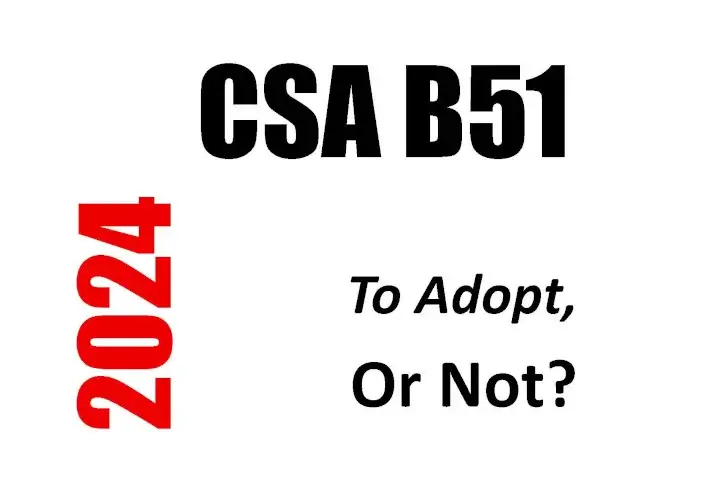No Canadian regulator has yet fully adopted the 2024 edition of CSA B51 outright despite its publication in April last year, nearly 1.5 years ago, given the issues it presents and divisive debate it generates. It is a mystery as to why these issues and debate were unresolved before publication. CRN registration depends on CSA B51 and until the issues associated with the 2024 edition are fully aired, the 2019 edition of CSA B51 is currently still in force in much of Canada.
As a result, in Alberta and other jurisdictions, the 2024 edition of CSA B51 remains unadopted after well more than a year. And in British Columbia, TSBC has not yet adopted the clauses relating to impact testing (6.2.6.1, 6.2.6.2, 6.3.7.1, and 6.3.7.2). Instead, perhaps regulatory directives can be used to address the safety issues while encouraging CRN registration consistency. ABSA is deliberating about how to proceed, and published direction from it and perhaps other regulators is reportedly anticipated this fall (see IB24-002 Rev 9 Note 2).
There is no guarantee that the 2024 edition of CSA B51 will be adopted.
Impact Testing of Carbon Steel is the Main Issue of Interest
Brittleness of carbon steel at cold temperatures is an indisputably known phenomenon and has been thoroughly studied since at least about the 1950’s and before. Much of Canada has a cold climate for much of the year, ranging well below -29C, and below where many carbon steels become brittle. In Canada, brittle behavior of carbon steel has been recognized, and studied, for well over half a century. And published data showing less brittle behaviour seems to be absent.
Brittle carbon steels are unable to absorb much impact energy from things like the blow of a hammer, or a big wrench, ….or abrupt pressure fluctuations, and they can thereby abruptly fail with potentially disastrous results. They can crack without much warning while containing pressure. Obviously, pressure equipment that suddenly and uncontrollably releases energy and contents is extremely dangerous.
It’s no secret that ten years ago, some carbon steel supplied to industry and conforming to the specifications for SA/A105, SA/A106B, or SA/A234, was observed to be brittle at temperatures much warmer than where brittleness was expected. No contradictory observations and no significant improvements to the associated specifications have since been published. Mandatory improvements to brittleness of carbon steel used in Canada have thereby not occurred since. Carbon steel rated for -29C can readily be specified and purchased in Canada, without impact testing, and thereby without convincing assurance of its suitability for use at -29C or colder temperatures.
Those For Impact Testing and Those Against It
Like any issue, there would seem to be two sides to this matter: those that are for impact testing and those that are against it.
Those against impact testing of carbon steel would seem aligned with reactive responses to future disasters, and would note that incidents involving untested and brittle carbon steel at cold temperatures have not been reported frequently, yet. They would probably further suggest that impact testing carbon steels would create an additional cost for them. Extra cost would quite possibly not be an issue though, since if a cold metal design metal temperature is specified, most suppliers will potentially opt to supply impact tested material anyway, to avoid possible liability. Cost increases would thereby be arguably minimal, and confusion about what material in inventory has been impact tested or not would potentially be removed.
Those for impact testing of carbon steel would seem to advocate for a proactive, safer approach. Obviously, and rightly so, safety is not based on luck or good fortune or just the absence of incidents; it is instead the result of careful, proactive thought and pre-emptive engineering, based on data, observation, good judgement, and margin.
CSA B51 Revisions to Impact Testing Requirements
Revisions in the 2024 edition of CSA B51 aim to address impact testing of carbon steel in clauses 6.2.6.1, 6.2.6.2, 6.3.7.1, 6.3.7.2. However, the proposed changes seem inadequate for several reasons, including:
- Notes 1 and 2 from Clause 7.1.1 of the 2019 Edition of CSA B51, which expressed precautions around the brittleness of SA105, SA106 and SA234, have been deleted without justification.
- Impact testing requirements for pressure vessels are labeled ‘Impact testing requirements for carbon steel pipe, fittings, and forgings’ in Clause 6.2.6 within ‘6.2 Design’, as if impact testing requirements for all those components are contained therein. Yet 6.2.6.1 and 6.2.6.2 only refer to pressure vessel components. This organization is inconsistent and confusing, and thereby inadequate.
- Despite Clause 6.2.6, which refers to impact testing requirements of designs, within ‘6.3 Construction’, impact testing for pressure piping is included in clause 6.3.7, as if piping construction needs a different type of impact testing than piping design. This organization is inconsistent and confusing, and thereby inadequate.
- Clause 6.3.7.1 requires that, for pressure piping system components, impact tests need not be done at temperatures colder than 0C for carbon steel rated, but untested, to -29C. Though this is an improvement on ASME code requirements, it is inadequate given the indisputable nature of transition temperatures, and published, uncontested data associated with carbon steel brittleness.
A simple fix to the above issues would seem to simply include removal of the reference to pressure vessels in Clause 6.2.6, in conjunction with the substantial removal of Clause 6.3.7.1.
The Way Forward
With the issues noted above, can the 2024 edition of CSA B51 be adopted without significant revisions? Can it be revised? Or is the 2019 edition safer, with its precautionary notes about the use of carbon steel in cold environments?
Who can say, other than the regulators themselves? They are the regulatory decision makers for this. And though the future can rarely be predetermined, with the assumption that public safety is of paramount importance to all decision makers, some guesses can be made. Here are some potential paths forward to consider:
- The CSA B51 committee could reconvene and address the impact testing issue pursuant to resolution with all Canadian regulators. This would admittedly be unlikely, given its publication and the extensive time that has expired thereafter; or
- The 2024 edition of CSA B51 could be adopted by all Canadian regulators. However given the reluctance to adopt the revisions to date, it seems unlikely that the 2024 revision will be adopted without significant directive documents to specifically address each regulator’s distinct concerns and perspective. Some regulators like ABSA typically adopt codes without revisions and occasionally with a supplemental directive that adds additional requirements as needed. The nature of the 2024 edition makes it unlikely that CSA B51 can be easily adopted solely with a supplemental directive; or
- The 2019 edition of CSA B51 could remain in force as it is, with supplemental directives affecting CRN registration issued by some regulators on a jurisdictional basis. In the absence of jurisdiction consensus, different impact testing requirements for CRN registration in different Canadian jurisdictions would be problematic in terms of CRN harmonization; or
- The 2019 edition of CSA B51 could remain in force as is, with no directives adversely affecting harmonization of CRN registration. However, supplemental directives addressing safety issues associated with impact testing to be enforced by inspectors could still be issued by regulators. In 2016, ABSA published Information Bulletin IB16-018 which referenced reports of industry experience with unexpected brittleness. Many of these concerns remain unaddressed, and though the 2019 edition of CSA B51 contained warnings in Notes 1 and 2 from Clause 7.1.1, in the interest of public safety ABSA may well now conclude that more than IB16-08 is needed. For example, ABSA and other regulators could perhaps make impact testing of carbon steel an inspection matter. They could require that supplemental impact testing is performed on new carbon steel material and related test reports are appended to required equipment data reports (see Sections 29(1)(b) and 31(1)(a) of the Alberta Pressure Equipment Safety Regulation) whenever the minimum design temperature of equipment is below 0C etc. And that testing would need to be to the satisfaction of an acceptable inspector, further to CRN registration requirements. Requirements for the inspection of materials potentially thereby need not affect consistent CRN registration harmonization. Further, records about carbon steel impact testing results could thereby be logged by regulators and data to indicate the prevalence of carbon steel brittleness could thereby be acquired. And finally, the amount of required carbon steel imact testing via inspections could be adjusted by each jurisdiction, to their own level of concern.
In Conclusion
Regardless of how impact testing issues associated with CSA B51 are resolved, several things are clear.
Like all codes, CSA B51 is meant to be a minimal requirement. Regardless of whether the 2024 CSA B51 edition is adopted or not, or whether jurisdictions publish further directives or not, engineers have an obligation through statutes like various engineering and occupational health and safety statutes across Canada, to hold public safety paramount.
Engineers have an obligation to not only meet minimal code and regulatory requirements, but to go beyond them when necessary to ensure public safety with safe equipment and designs. This means that in Canada, when the temperature gets cold, only suitable material is to be used after adequate testing.
The way forward should clearly address carbon steel embrittlement with careful, proactive thought and pre-emptive engineering, that is based on available data, observation, good judgement, and margin.




